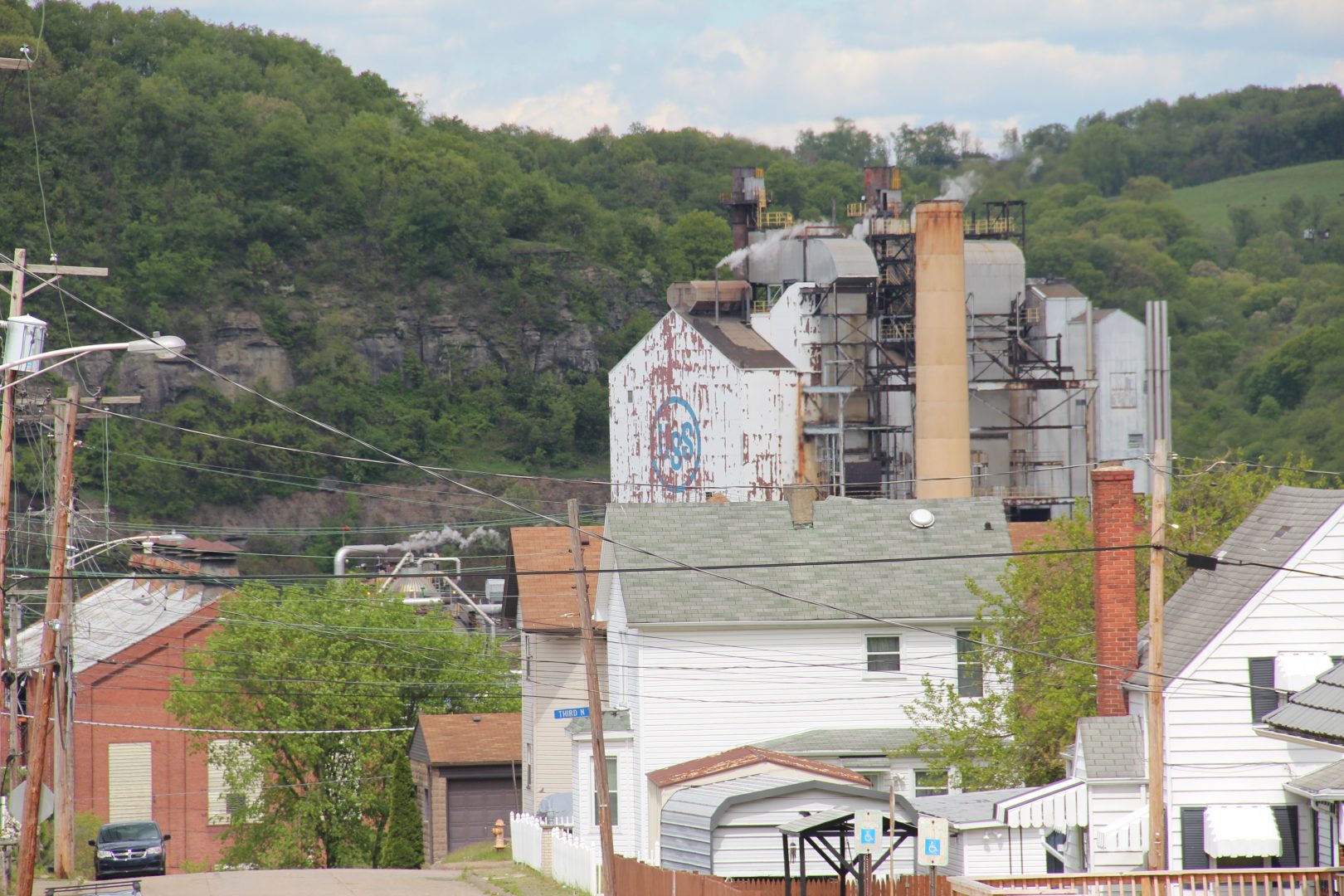
US Steel's Clairton Coke Works.
Reid R. Frazier / StateImpact Pennsylvania


US Steel's Clairton Coke Works.
Reid R. Frazier / StateImpact Pennsylvania

Reid R. Frazier / StateImpact Pennsylvania
US Steel's Clairton Coke Works.
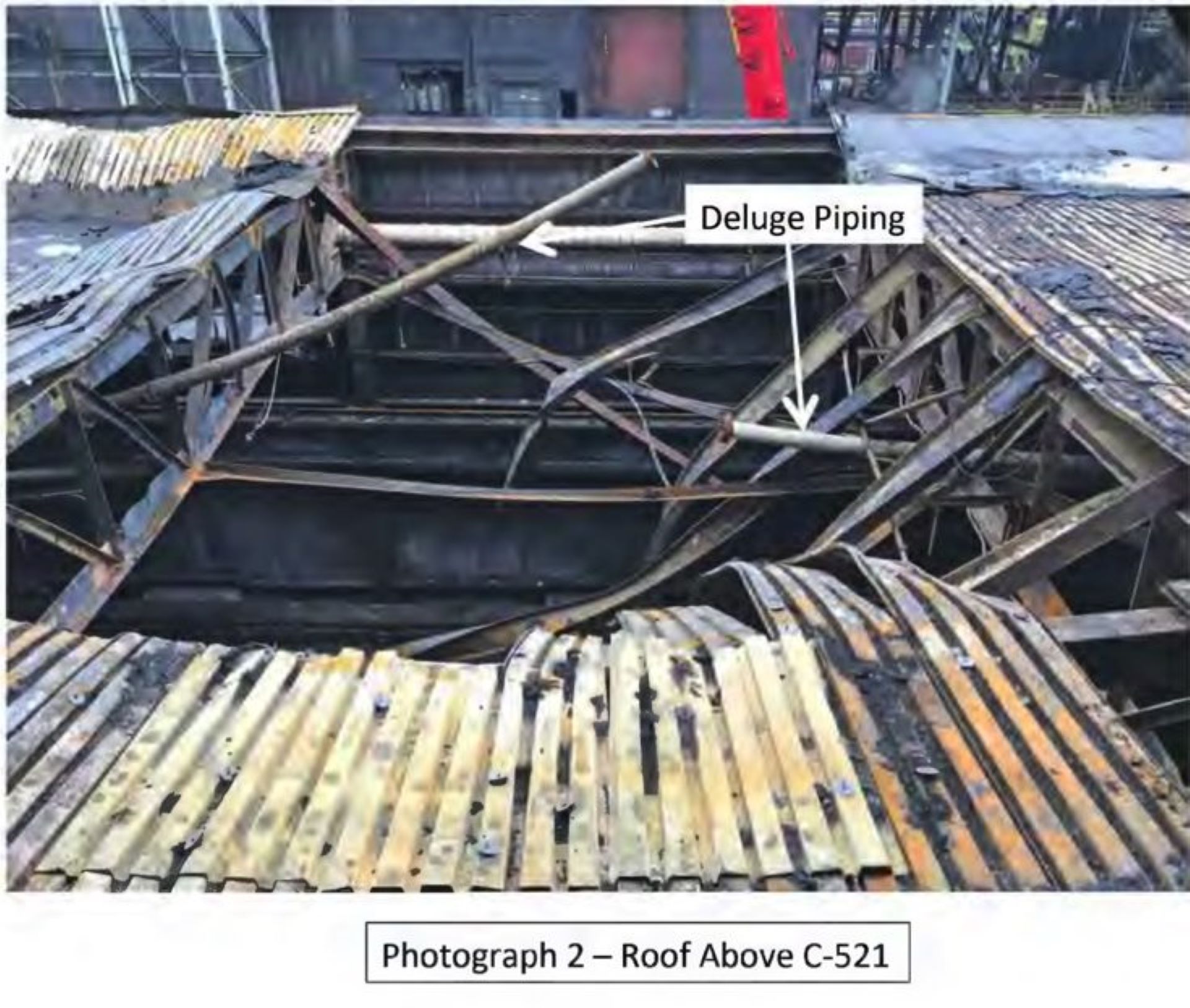
EDT/U.S. Steel
Roof above Control Room #2 post-fire showing deluge (sprinkler) piping.
No one knows exactly when the roof of Control Room # 2 at U.S. Steel’s Clairton Coke Works started to leak. But leak it did, probably for “years”, in the words of one investigator hired by the company.
Control Room #2 is an industrial building inside the coke works complex, about 20 miles south of Pittsburgh. It houses key parts of the plant’s pollution control system, which keeps thousands of pounds of harmful pollution out of Pittsburgh’s air every day.
The leaking water dripped liquid onto the building’s sprinkler system, where it corroded a pipe joint until “no metal remained” in some parts of the joint; in other parts, the joint was just “paper-thin metal”, the investigators found.
Finally, the pipe joint gave out, and on Dec. 24, 2018, around 4:12 am, the sprinkler system came crashing down, severing a pipe filled with lubricating oil, which would catch fire moments later.
Witnesses later said they heard a rumbling sound, the sound of metal striking metal, then machine alarms. Investigators concluded the falling pipes precipitated a cascade of failures made worse by corroded or already-broken equipment that engulfed the whole building in flames.
By the following day, the Clairton plant, the largest coke-making facility in the U.S., by far the region’s largest single source of several major air pollutants, was without key pollution controls and would remain so for three months.
The precise sequence of events that led to the blaze, and results of the company’s investigation into its origin, have been detailed for the first time in documents made public in recent months in a federal lawsuit against the company.
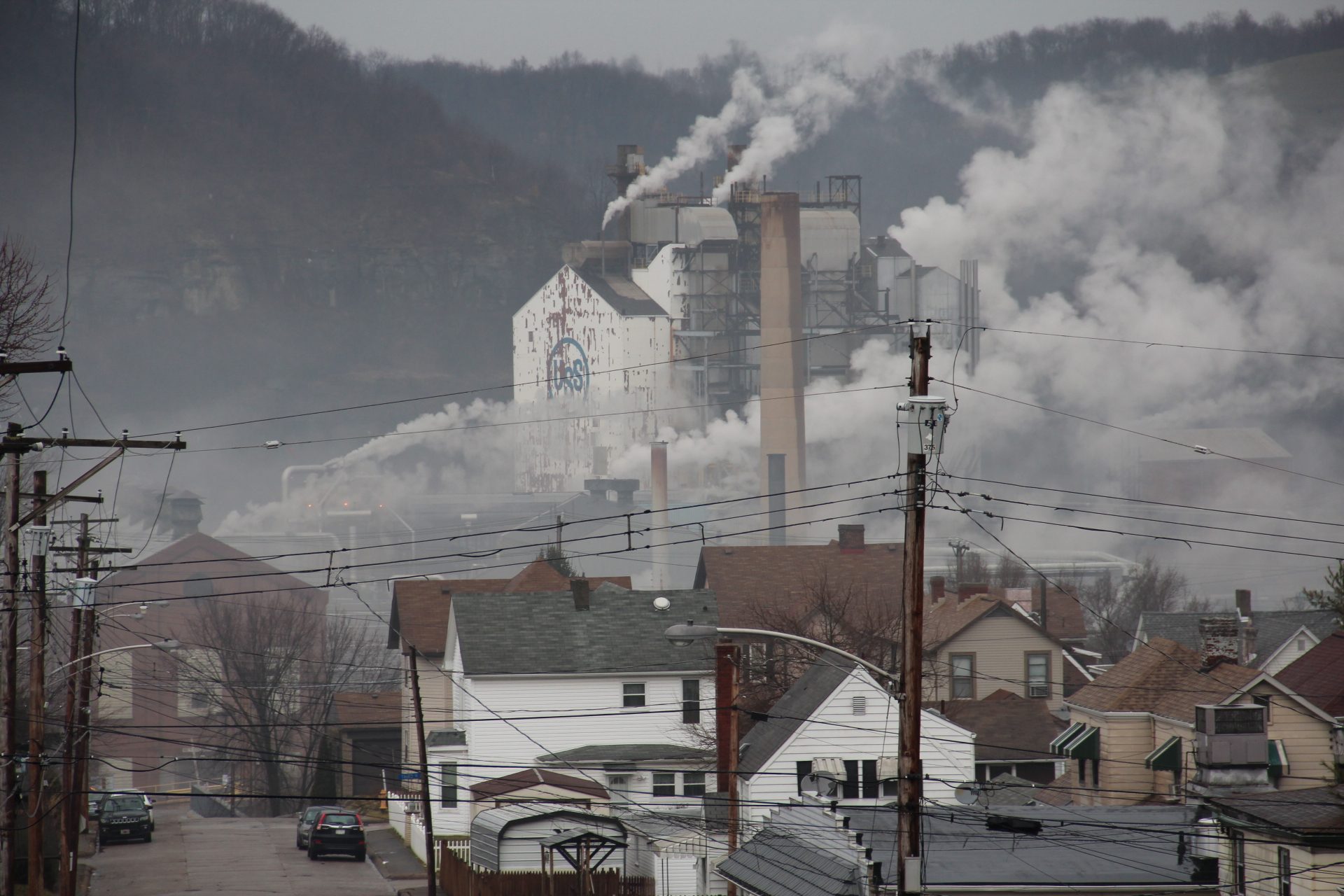
Reid R. Frazier / StateImpact Pennsylvania
U.S. Steel’s Clairton Plant, the largest coke works in North America, in Clairton, Pa.
The documents show the structural deficiencies that led to the loss of the plant’s pollution control system, which forced Pittsburghers to breathe air fouled with sulfur pollution and harmful particle pollution over the course of more than 100 days after the event.
The event caused asthma cases to spike, and upticks in hospitalization and medicine use among asthma cases.
The plaintiffs are two environmental groups, PennEnvironment and the Clean Air Council, and the Allegheny County Health Department. The environmental groups represent several area residents who claim they have suffered health effects from the pollution caused by the fire.
The plaintiffs are asking a federal judge to find the company guilty of committing over 12,000 violations of the Clean Air Act, and to order the company to implement the necessary upgrades so that the plant will never again go without air pollution controls. The judge has ordered a hearing in the case in January.
The plaintiffs are arguing that plant conditions, which one government official called ‘decrepit’, and the company’s inadequate safety and inspection protocols made the fire inevitable.
U.S. Steel, meanwhile, says in legal briefs that the fire was an accident, that it has spent millions fixing and upgrading equipment at Clairton, and has argued that air pollution resulting from the fire never threatened public health.
Amanda Malkowski, a company spokesperson, declined a request for comment about the case. “It is a matter of corporate policy that we do not litigate in the court of public opinion and rely on the legal process to determine the legitimacy of any claims,” Malkowski said in an email.
Until pollution controls were restored, on April 5, the plant flared untreated coke oven gas, resulting in increased emissions of sulfur dioxide, which can harm the human respiratory system and make breathing difficult, especially for people with asthma.
The plaintiffs report that U.S. Steel’s emissions of sulfur dioxide, went from one ton per day before the fire to 45 tons per day after the fire, or a 4500 percent increase.
Studies conducted since showed that the fire and resulting air pollution worsened breathing for asthma patients and increased the number of emergency room visits for asthma.
Thousands of air quality complaints rolled into the Allegheny County Health Department, many complaining of a sulfurous, rotten egg smell; one complainant said the smell was so bad they could not even let their dogs out.
Air pollution levels surged above federal safety standards several times. The health department took the unorthodox step of urging people in at-risk groups, like those with asthma or heart conditions, children, and the elderly, to simply avoid being outside as much as possible.
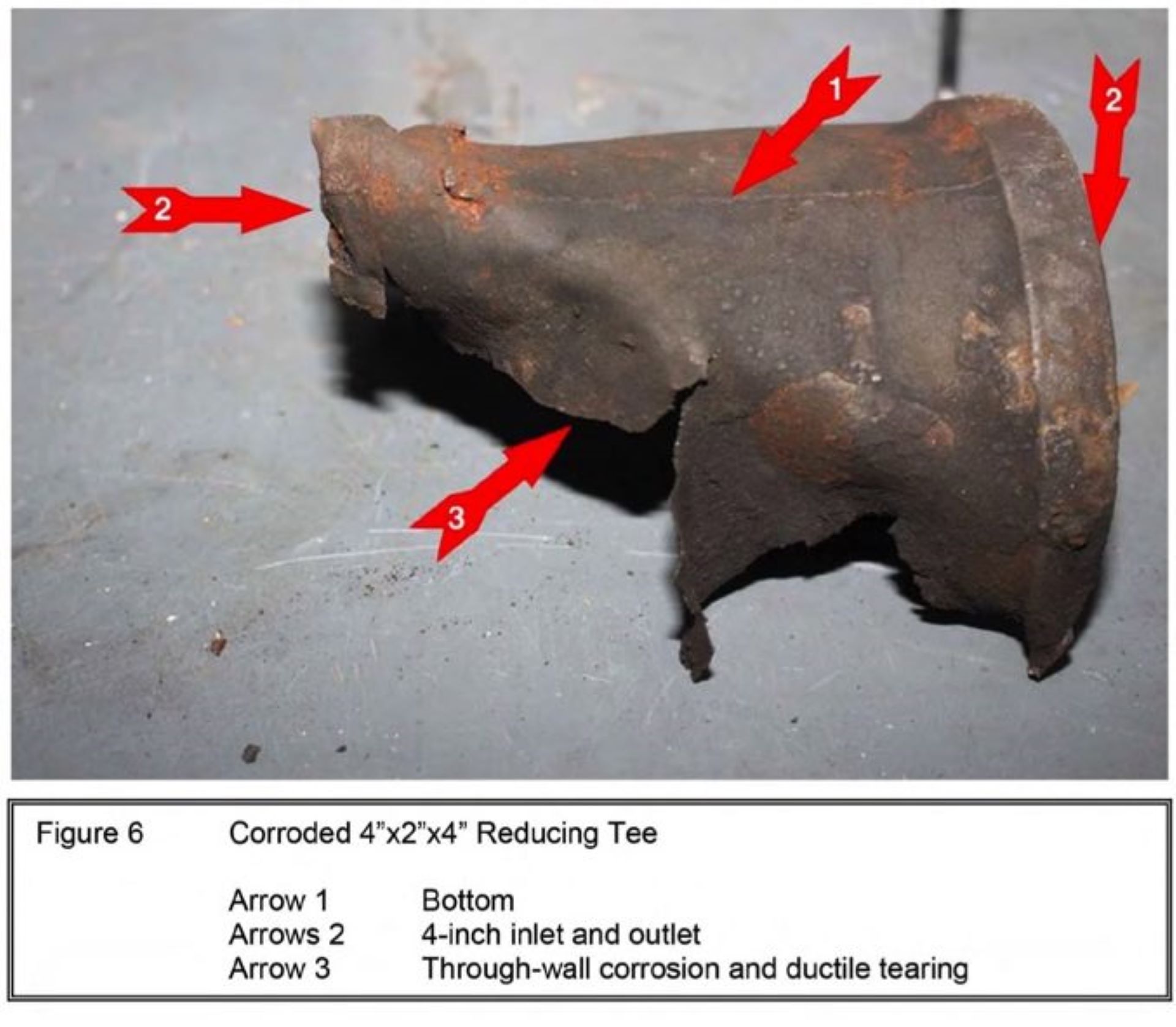
EDT/U.S. Steel
The corroded tee joint.
All of this began with one corroded pipe joint, investigative documents made available in the case show. The ‘tee’ joint, also called a coupler, connected pieces of 4-inch diameter metal pipe in the sprinkler system.
But it wasn’t the only piece of equipment that failed in the morning hours of Dec. 24, 2018. A rotor shaft inside a compressor was almost completely fractured by the time the pipe joint failed; its subsequent break would cause a large gas leak that made the fire bigger and more destructive.
And a backup valve that could have prevented the fire from spreading malfunctioned because of corrosion, according to reports by US Steel’s investigators. All of the failures were the result of corroded equipment. None had been caught by U.S. Steel inspectors in time.
The failures began in the building’s sprinkler system, 45 feet above the industrial compressors and heavy machinery on the building floor. Water from an undetected roof leak combined with sulfur from the industrial emissions inside the plant, and dripped onto the ‘tee’-shaped plumbing joint.
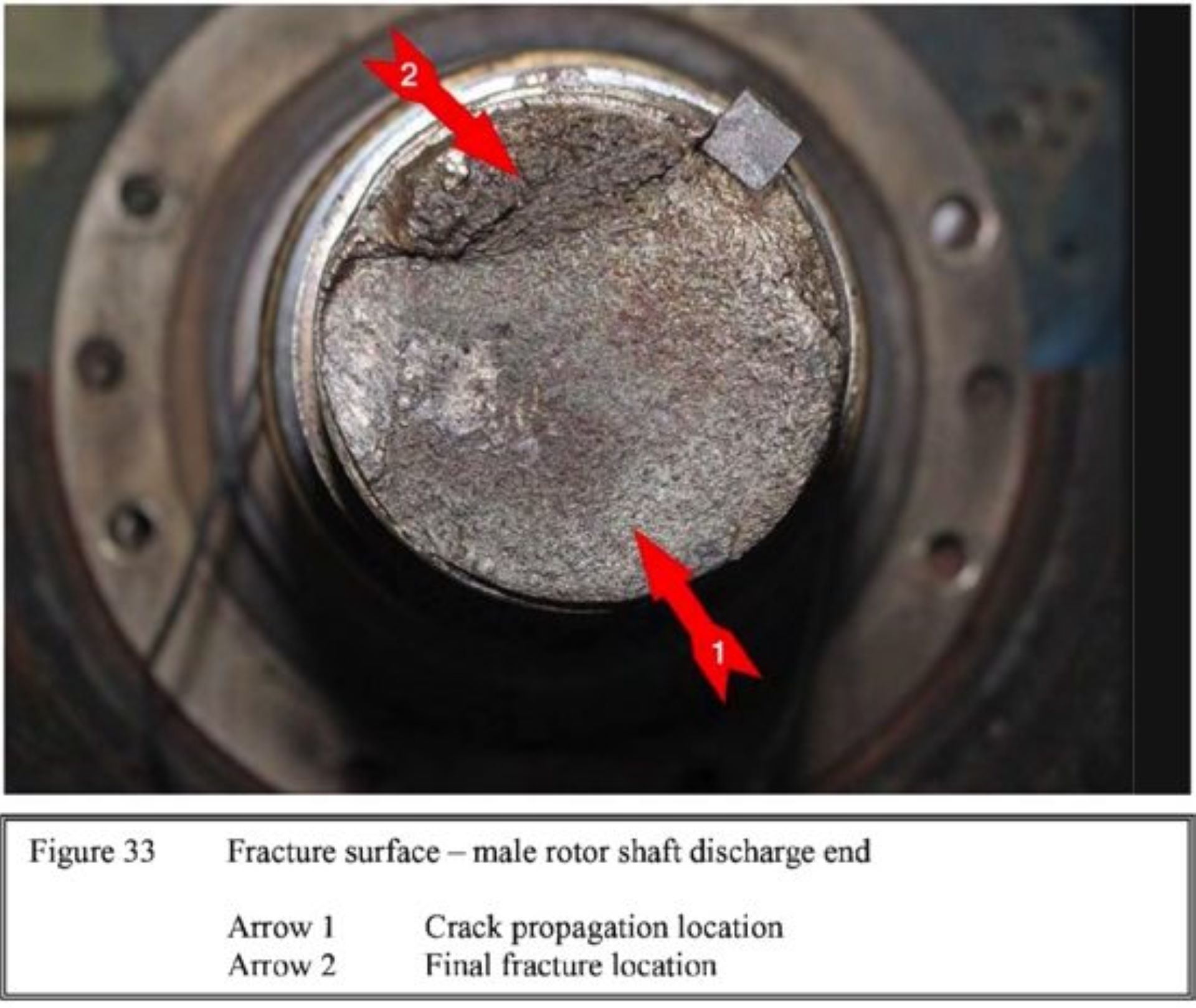
EDT/U.S. Steel
This image shows the a closeup cross-section of fractured rotor shaft, showing 80-percent pre-existing fracture.
The sprinkler system had been installed when the building was constructed in the late 1960s. The company had only done visual inspections of the sprinkler system from the floor of the control room in recent years, according to a report by Engineering Design and Testing (EDT), the Conn.-based engineering firm U.S. Steel hired to investigate the fire.
The report has been made public as a result of the lawsuit. According to the report, the corrosion on the tee joint was concentrated on the top-side of the pipe joint, thus “rendering the condition of the (corrosion) not visible to an inspector viewing the (sprinkler) system from the floor of No. 2 Control Room.”
The sprinkler system included several sections of metal pipe, suspended from the ceiling with metal hangers. But court documents show that for years, the hangers were in a state of disrepair.
EDT found the hangers showed “long-term deterioration since installation circa 1967 so as to compromise the load carrying capacity of the hangers.” EDT reported that in 2003, an inspection of the system found hangers to be corroded or deteriorated in places; investigators could find no record of hangers being repaired in the area where the failure occurred.
An inspection done after the fire showed “loose hangers” on other parts of the sprinkler system. EDT concluded “all indications are that long-term deterioration had affected the integrity of the hangers/supports that comprised a portion of the [sprinkler] system,” where the sprinkler system failed.
One of the falling sprinkler pipes severed a line carrying lubrication oil into one of the room’s large industrial compressors. The severed line spilled oil, which ignited at a nearby steam line.
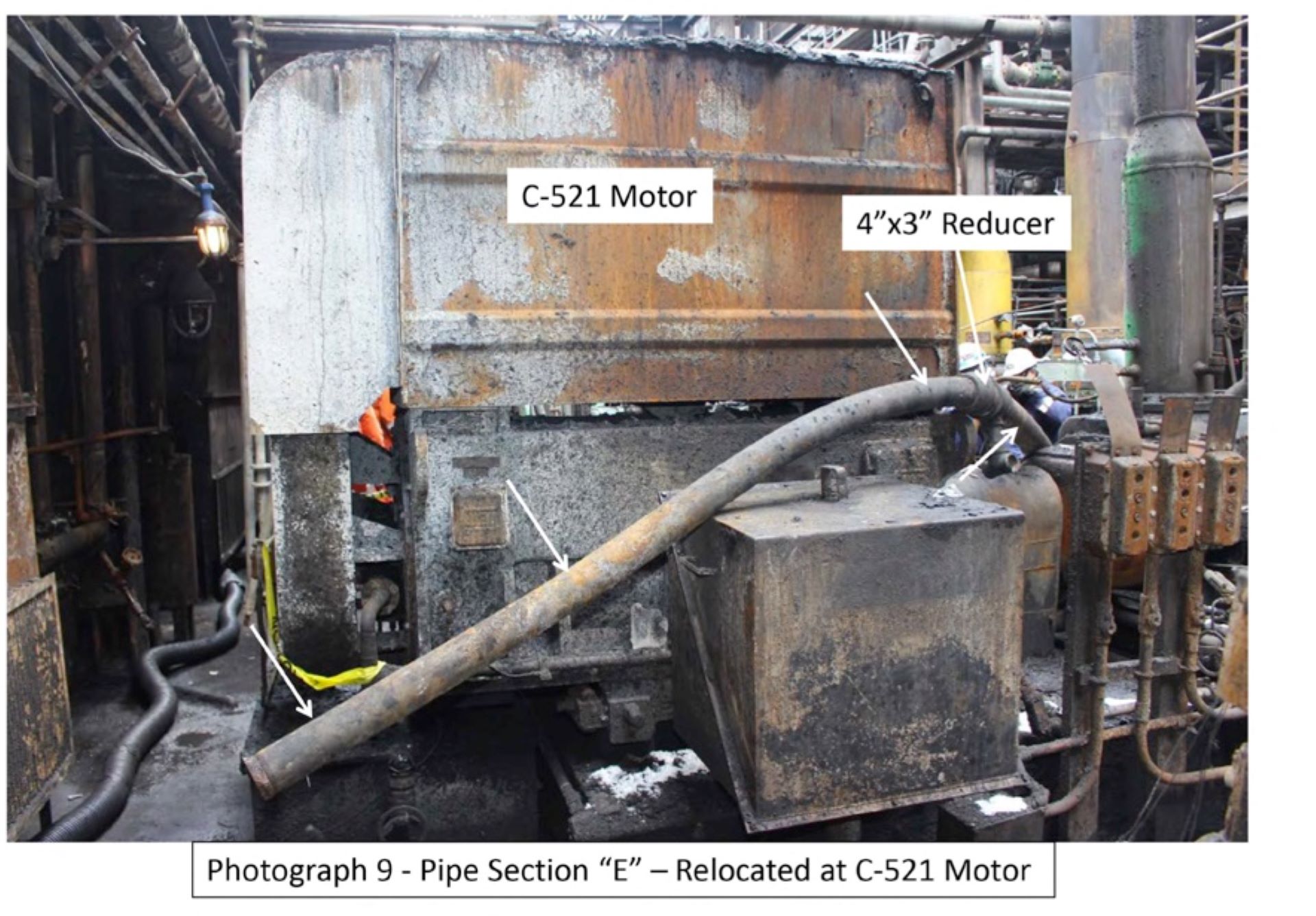
EDT/U.S. Steel
A section of the sprinkler system that collapsed at Clairton Coke Works.
The break in the line also dropped the oil pressure inside the compressor, which pushes waste gasses through the plant’s pollution control system. A rotor shaft inside the compressor was thrown off by a fraction of an inch, EDT concluded.
Investigators later discovered the shaft was already corroded, and had a fracture through 80 percent of its diameter. With that much pre-existing damage, the shaft snapped in two after the drop in oil pressure.
The compressor kept working, however, and with only part of the rotor shaft intact, it began vibrating with enough force to loosen bolts in various parts of the machine, according to EDT.
Bolts holding a junction of two sections of a gas pipe fell off; the pipe separated, releasing gas into the room, which soon ignited on the already-burning lubrication oil fire.
Even at that point, damage to the room might have been contained, investigators found, but for another failure: this time on a braking mechanism inside the pipe called a “check” valve.
When working properly, the valve would have stopped the flow of gas after the pipe separation; but the valve was also corroded, and failed to close; gas flowed freely into the room, sending the room into flames.
The company’s investigators concluded that these cumulative failures, all caused by long-term corrosion at the plant, made the fire worse than it otherwise would have been.
Had the cracked rotor shaft not fractured, the fire from the severed oil line “would be expected to have resulted in far less damage to the No. 2 Control Room, since the fire would have been contained,” the investigators wrote.
They noted the cracked rotor shaft would likely have failed at some point in the near future, but lacking a nearby ignition source, a fire would have been unlikely.
The plaintiffs in the case argue that U.S. Steel should have caught these mechanical defects before the catastrophic events, especially given the fact that the room had a history of problems: In addition to the Dec. 24 fire, the control room had experienced accidents, fires, and explosions in 1997, 2009, 2015, and again in June 2019, after an electrical failure resulted in a fire in the building.
They note that the company had cut back its maintenance staff at Clairton, which was originally built in 1901. A report prepared for U.S. Steel by the consulting firm McKinsey, obtained by the plaintiffs in the case, showed that the maintenance staff at U.S. Steel’s three Mon Valley plants, which include Clairton, fell from 1,019 in 2016 to 691 in September 2018.
They also point to testimony from Jim Kelly, former deputy director of environmental health at the Allegheny County Health Department, about the plant’s condition. In a 2020 deposition, Kelly said that he toured the facility in 2017 and found it “one of the most decrepit facilities I’ve ever seen in my nearly 30 years of work.” Kelly said the facility had “lots of rust and unused equipment, and just generally … poor conditions of a lot of the equipment there.”
The plaintiffs also note that conditions at the plant appeared lacking even after the accident. A 2020 inspection by the U.S. Steel contractor System One, reviewed by the plaintiff’s expert witness, found gas leaks, holes in piping, broken pipe supports, sagging pipes, and pipes with severe corrosion at the plant.
Several of the defects were classified by the contractor as “Severity Code 1” — problems that required immediate action. The reports were reviewed by industrial engineer Ranajit Sahu, an expert witness hired by the plaintiffs.
“The state of disrepair noted in these System One findings is beyond concerning,” Sahu wrote in a report summarizing his findings. “It appears that the ability to simply ensure that fluids and gases remain within piping is not assured at Clairton.”
Lawyers for U.S. Steel argue that the company has spent “at least $17.5 million to improve, repair, and upgrade its facilities” following the Dec. 24 fire, and a subsequent fire in June, 2019, that knocked out the pollution controls for one day.
They argue that pollution levels in the region “were lower than historic levels in the area” and that they never reached levels “that could cause adverse health responses or symptoms in even the most sensitive populations.”
The plaintiffs are asking a federal judge to find that U.S. Steel committed over 12,000 clean air violations in the months after the fire. Each violation would have a maximum fine of $102,000, says Zach Barber, clean air advocate at PennEnvironment. Barber doubts the company would pay the maximum fine, but he wants the company to pay an amount greater than the money it saved by not performing needed maintenance at the plant.
“We want to make sure that U.S. Steel is held accountable, that it doesn’t [just] ‘pay to pollute’,” Barber said.
After the judge rules on whether U.S. Steel committed Clean Air Act violations, Barber said the next phase of the suit would be to determine a remedy. The plaintiffs say that could include a back-up pollution control system, since the fire in Control Room #2 shut down all of the plant’s ability to take harmful sulfur compounds out of its waste gas.
“We want to fix the underlying problems at this facility that enabled something like this to happen in the first place,” Barber said.
The Allegheny County Health Department is asking the judge to force the company to “develop and implement a plan for hot idling” of coke oven batteries within 30 days of a major pollution control shutdown, and ensure that the plant will be able to treat its gas even if one part of its pollution controls goes offline for “an emergency or planned outage”.
The county is asking the judge to order U.S. Steel to submit to a court-appointed audit “to ascertain what remedial, supplemental, or redundant measures can be taken” to ensure that the company never experiences an outage of its pollution controls again. It wants the judge to order U.S. Steel to implement the audit recommendations, provided the annual costs of implementing that plan do not exceed 3 percent of the company’s “net revenues”; its “net sales” were $9.7 billion in 2020.
Barber said the purpose of the lawsuit is for the company to assure the public that the county will never experience a repeat of the Dec. 24 fire.
“They need to actually improve the backups at this facility, make sure that they have taken precautionary steps to be able to deal with something like this if and when it might happen again,” Barber said. “There’s every reason to believe that they need to be ready to deal with it when it happens again.”
StateImpact Pennsylvania is a collaboration among WITF, WHYY, and the Allegheny Front. Reporters Reid Frazier, Rachel McDevitt and Susan Phillips cover the commonwealth’s energy economy. Read their reports on this site, and hear them on public radio stations across Pennsylvania.
(listed by story count)
StateImpact Pennsylvania is a collaboration among WITF, WHYY, and the Allegheny Front. Reporters Reid Frazier, Rachel McDevitt and Susan Phillips cover the commonwealth’s energy economy. Read their reports on this site, and hear them on public radio stations across Pennsylvania.
Climate Solutions, a collaboration of news organizations, educational institutions and a theater company, uses engagement, education and storytelling to help central Pennsylvanians toward climate change literacy, resilience and adaptation. Our work will amplify how people are finding solutions to the challenges presented by a warming world.